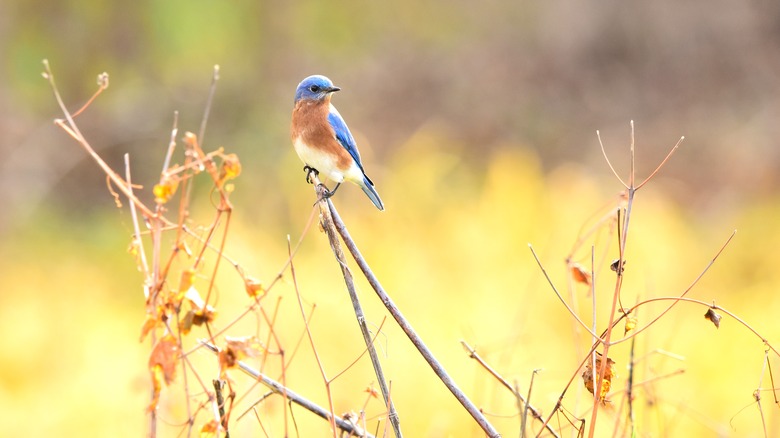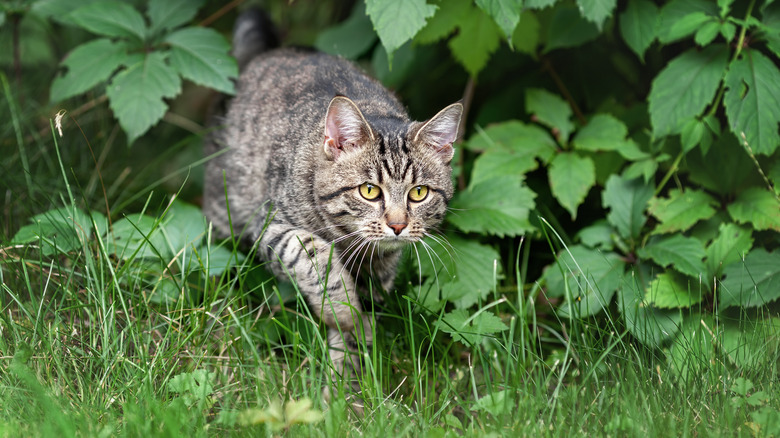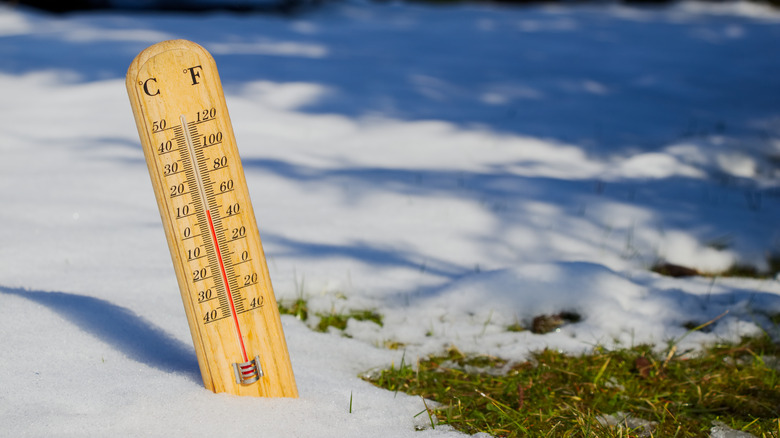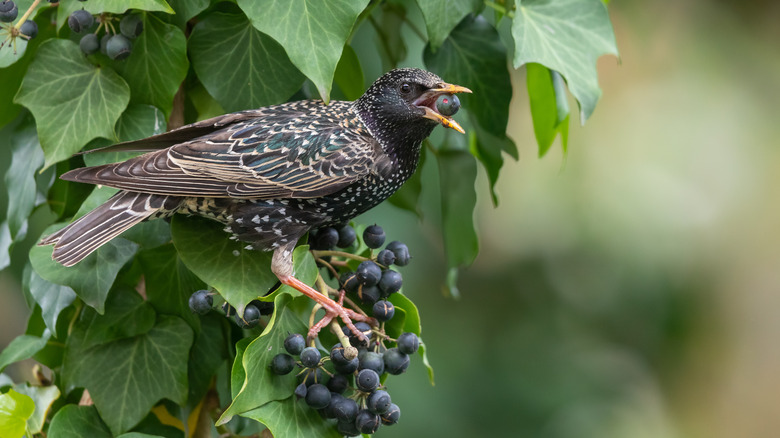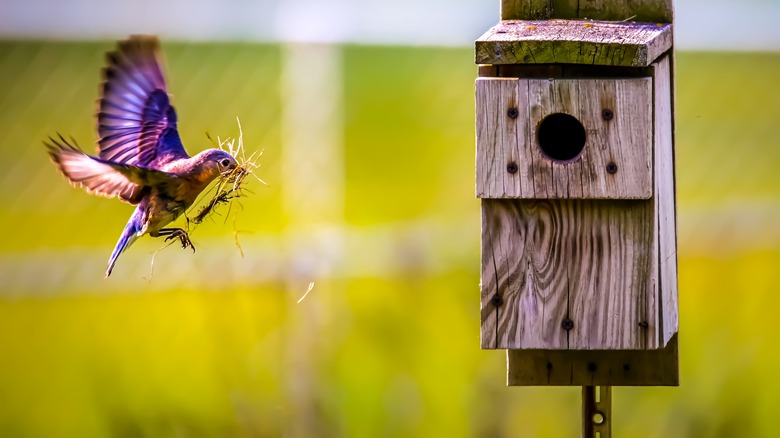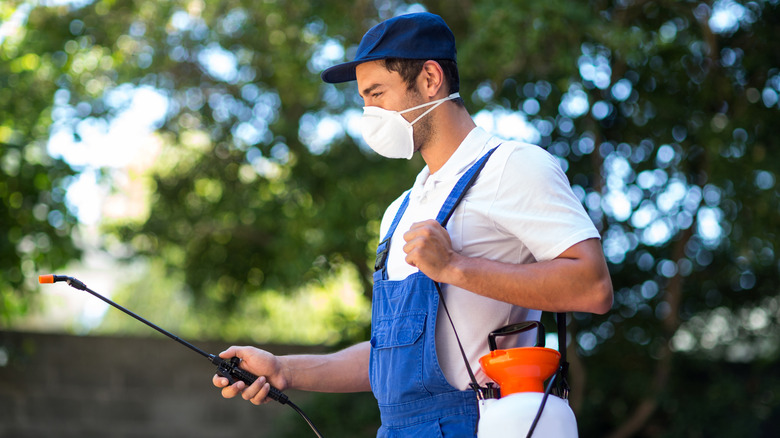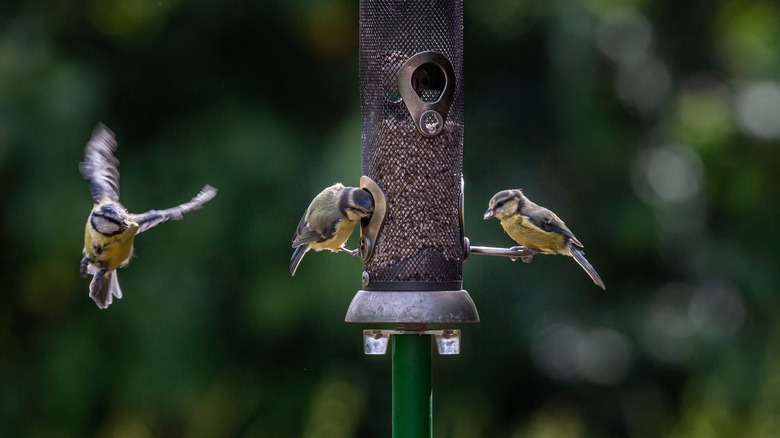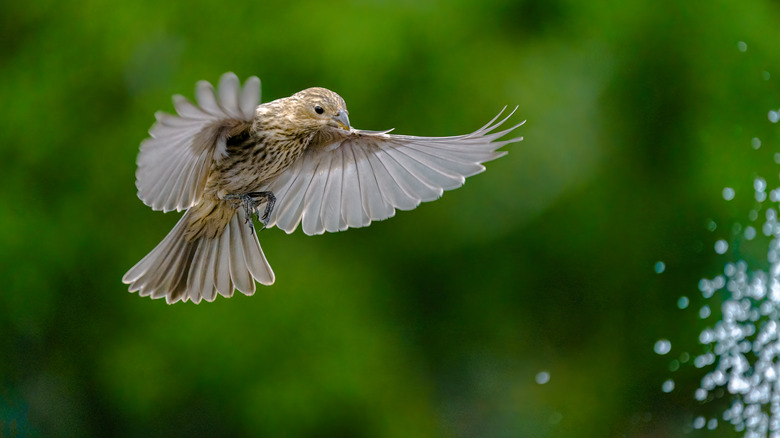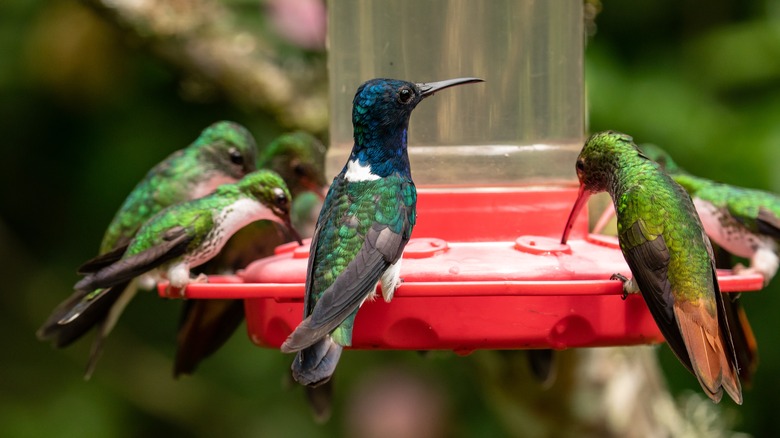8 Reasons Birds Are Avoiding Your Yard And What To Do About It
Birds in your yard bring a flash of color, a flutter of wings, and the sound of nature's musicians right to your back door. But have you noticed a decrease in those natural wonders lately? Does it seem like the cacophony of birds inhabiting your backyard was more prevalent a few years ago? We've heard about a decline in bumblebees and other crucial species due to factors such as food supply and warmer weather, and it seems that birds are also feeling the effects of these changes.
The sight of flapping feathers around your backyard and the twittering of early-morning bird songs contribute to a peaceful atmosphere so many of us love about our outdoor space. However, birds play a far more important role in our world than just providing pretty sights. For example, our ecosystem relies heavily on birds to disperse seeds and cut back on mosquitoes and other insects that could become too prevalent. Certain species, such as hummingbirds and orioles, help pollinate, while others keep rodent populations in check. If your birds are disappearing, it may be an indicator of more tangible problems to come.
If your yard used to be a haven for birds and you're noticing fewer and fewer each year — or perhaps your yard has never been home to birds — here are all the reasons why your backyard might be bird-free and how to turn that around.
There are predators afoot
Nearby predators could be deterring birds in your space, and a few of the culprits might surprise you. Birds, like every other animal, are part of a delicate system of prey and predator. Although birds are often quick, camouflaged, and can shoot into the skies away from danger, they too fall somewhere on the food chain. Although this natural cycle cannot and shouldn't be entirely disrupted, an abundance of predators in your backyard could terrify the nearby bird population. Whether it's the neighborhood cat or a more serious predator lurking, something could be hunting the birds right out of your backyard.
One of the big suspects when it comes to bird predators is cats. Domestic and undomesticated cats alike can scare the birds straight from your backyard, even if it's a haven in every other way. Some studies indicate that the number of birds annually killed by cats can get into the billions, and that's just in America. Other de facto predators that can cause birds to avoid your yard are squirrels, which can raid feeders and bird nests. Snakes also tend to attack birds, especially when their nests and feeders are easily accessible. One tip to deter snakes in your yard is to place feeders and birdhouses on metal poles, which are difficult for snakes to climb. Other predators include foxes, dogs, raccoons, and other larger animals that either target the birds themselves or their more susceptible eggs and nests.
It's that pesky weather
Natural changes in the weather are a given and the shifting seasons trigger a bird's response to begin their migration or call them back home. However, unpredictable weather patterns caused by global warming and rising temps are also taking a toll. Warmer winters and less predictable spring temperatures have impacted not only birds' natural migration patterns, but also played a role in the dwindling of certain species. About two-thirds of North American birds head to warmer areas when insects and other food sources become scarce in colder weather, which means any disturbance to this delicate ecological system could seriously impact a bird's odds of survival.
Most migrations happen in the fall when the weather begins to shift to cooler temps that not all species are equipped to handle. However, the weather change is just as important at the beginning of spring. This is a time when insects and other bugs emerge from the dark. These insects are a crucial part of the bird food chain and upon first hatching, provide an incredibly rich and nourishing diet for birds. The problem is that with changing weather patterns and what are known as false springs, the birds are returning only to find that they've missed the bug buffet, and certain important plants and flowers have been damaged in unexpected frosts. This critical window of time could be dwindling the number of beneficial birds you want in your yard.
Your yard lacks natural habitats for birds
A concrete jungle isn't an alluring environment for birds. In order to bring in those birds, you'll need to create a natural sanctuary where they can not only survive but thrive, or they won't have a reason to stick around. Birds, like other animals, rely heavily on their natural habitat for shelter, a steady food supply, and a safe nesting area to reproduce. As our population grows, our own need for shelter has begun to encroach on the natural habitat of various species of birds. As trees, shrubs, vines, and foliage are replaced by parking lots, manicured suburbs, shopping centers, and highways, several species of birds have been forced to make their homes elsewhere. The good news is that with just a few simple steps you can transform your barren backyard into a thriving bird sanctuary.
One simple step to bring the birds back to your yard is creating a habitat that offers everything they need: food, water, and a safe shelter. To offer a food supply, consider planting shrubs and trees that are loaded with fruit, seeds, and nuts to keep birds satisfied. Check with the National Wildlife Federation to see what native plants are best suited for your area and the local bird population. Birds also love a fresh water supply, which is easy to add to your yard, and the soothing sound of water will be an added bonus for you. Consider a simple bird bath if you can't create a running water feature. Even a bucket of fresh water year-round will often attract birds.
Your birdhouses need improvement
Every detail about your birdhouses could impact whether our flying friends decide to set up camp or simply pass by. It may seem like a bird would happily hunker down in a premade house, but they are, in fact, quite particular and even small details can have them turning up their beaks. You need to carefully consider the placement, the type of wood, nearby food supplies, the size of the hole, the lighting, and more if you're going to figure out the real reason why birds are avoiding your birdhouse. Once you discover the problem you can get down to righting the wrongs, but one thing is for sure — it's a much more thoughtful process than nailing a wooden box to any old tree in your yard.
Possibly the most important factor to consider is where to place or hang your birdhouse. Predators are a major concern for birds and their nests, which means they won't sacrifice their safety for the convenience of a premade birdhouse. Try placing your birdhouse somewhere in the open where the birds won't feel cornered or trapped, such as the edge of your yard or a quiet back corner. Don't place a birdhouse right by your back patio where the door screeches and bangs every time it opens or closes. In theory, it sounds great to have a front-row look at these fascinating creatures, but certain species can be hesitant around people, pets, and loud noises, and likely won't settle near potential threats or disturbances. You might think tacking a birdhouse to a nearby tree is a no-brainer. However, a tree makes a birdhouse an easy target for other wildlife.
Chemicals and pesticides are killing insects and plants that attract birds
Does your lawn look particularly lush this year? Have you or your landscaper been applying supposedly harmless pesticides to keep weeds and destructive insects away from your yard? Unfortunately, spraying weedkiller and insect repellent around your yard, sidewalks, porches, and more can have a negative impact on wildlife. Not only do these commonly used chemicals disrupt a bird's natural food supply by killing certain bugs, but there have been instances of granule pesticides being mistaken for food and consumed by birds. Recent studies have shown that Americans use a staggering amount of pesticides a year and they often contain serious toxins. Although these chemicals must be registered under the Environmental Protection Agency, it's difficult to regulate individual use of the pesticides. It's no surprise that wildlife would shy away from chemicals such as these.
If you want to attract birds but worry about the appearance of your outdoor areas, there are plenty of tips and tricks to try that will make growing a healthy yard without harsh chemicals a breeze. These less disruptive methods will result in a space where you, your family and friends, your pets, and the birds can feel safe from harsh ingredients. For example, pouring boiling water on persistent weeds has proven to be an effective, harmless, and inexpensive way to battle stubborn plants.
Your feed and feeders are lacking
It's tough news to break, but if you're haphazardly tossing birdseed around your yard, that's no guarantee that winged wonders will come flocking. Bird feeders are another component of your yard that must be carefully considered and take a bit more planning than you might've originally thought. For example, certain types of bird seed attract different types of birds. Have you checked whether your bird seed attracts native birds or far-off species that might never pass through your yard? It's important to understand what birds are looking for to not only attract them but to keep them coming back. If you've tried making your own DIY bird seed or if the squirrels are ravaging your supply before the birds can settle in, it's time to ask yourself if your feeder is lacking.
If you're supplying the local birds with plenty of food and they still aren't visiting, this is a sign that there's a problem. However, you'll want to keep an eye on the other wildlife as well. For example, are the squirrels turning up their noses at the bird feed? If the supply sits for long periods of time and isn't attracting any natural hunters, this could be a sign that the seed has gone bad. Double-check that the seed isn't visibly damp or moldy to begin with and then determine if there's a bad odor. If the seed seems off to you, it might be worth it to simply purchase a new feed.
Sound pollution can deter birds
Is your backyard a setting for noise and chaos? Loud noises can deter birds from their natural habitat. You might think that if you don't live beside a busy highway, noise pollution isn't a problem. However, the truth is even seemingly harmless sounds such as lawnmowers, music speakers, agitated dogs, loud neighbors, blaring TVs, and more can put birds into a seriously stressful state. In fact, they can cause a bird to leave and never return to that area, even if they have a nest there. Noise has become such a problem that it's one of the major threats to bird populations, even in their natural habitats.
Although you cannot always control the noise around your yard, there are small things you can do to decrease noise pollution. For example, you can limit the use of speakers when outside, or at least use them at a lower volume. If you're having a barbecue, consider keeping the noise to a minimum. Your neighbors and the birds will thank you. Another tip is limiting the use of large machinery. You can also install sound barriers or plant more trees around the edge of your yard to attempt to diminish unwanted sounds. If the noise in your neighborhood is too difficult to manage, you can at least move your birdhouses, baths, and feeders to the quietest area in your yard.
Your yard lacks the colors that attract birds
A colorful backyard full of bright flowers is a sight for sore eyes. The great news is that those pops of color are not just pretty to look at, but they also play a role in capturing the attention of birds. In fact, birds are one of the few animals that can see colors, which means colors play an important role in birds finding a mate, camouflaging themselves, and looking for potential food sources. Interestingly enough, there are at least seven colors that attract more birds to your garden and at least one that does the opposite.
To elevate your backyard and attract birds, you'll want to avoid the color white. It's believed that a flash of white is often viewed as a warning of a potential threat to birds. Other colors to consider depend on the species. Red is often viewed by hummingbirds as a source of food, which is also why most hummingbird feeders have a splash of red. Shades of pink and purple call chickadees or woodpeckers to your space, while — ironically enough — blue flowers will attract blue jays and bluebirds to the party. For those who love goldfinches, a bright yellow or gold flower often does the trick. Next time you're planting your spring flowers, try choosing the colors that you know will attract those native, but sometimes elusive species that you'd love to see in your backyard.
